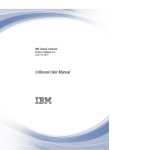Download Wiley ASP.NET AJAX Programmer's Reference: with ASP.NET 2.0 or ASP.NET 3.5
Transcript
AL
RI
AJAX Technologies
D
MA
TE
Traditional Web pages use server-side technologies and resources to operate and deliver their
features and services to end users. These Web pages require end users to perform full-page
postbacks to the server, where these pages can run the required server-side code to deliver the
requested service or feature. In other words, these Web pages use the click-and-wait, userunfriendly interaction pattern, which is characterized by waiting periods that disrupt user
workflow and degrade the user experience. This click-and-wait user interaction pattern is what
makes the traditional Web applications act and feel very different from their desktop counterparts.
GH
TE
Asynchronous JavaScript And XML (abbreviated AJAX) is a popular Web application development
approach that uses client-side technologies such as HTML, XHTML, CSS, DOM, XML, XSLT,
Javascript, and asynchronous client-callback techniques such as XMLHttp requests and hidden-frame
techniques to develop more sophisticated and responsive Web applications that break free from the
click-and-wait pattern and, consequently, act and feel more like a desktop application. In other
words, AJAX is closing the gap between Web applications and their desktop counterparts.
PY
RI
This chapter begins by discussing the main characteristics of AJAX-enabled Web pages in the context of an example.
CO
Google Suggest
The Google Suggest Web page (www.google.com/webhp?complete=1) contains an AJAX-enabled
search box that completes your search items as you type them in, as shown in Figure 1-1. Under
the hood, this AJAX-enabled search box uses AJAX techniques to asynchronously download the
required data from the Web server and to display them to the end user without interrupting the
user’s interaction with the page. All the client-server communications are performed in the background as the end user types into the search box.
An AJAX-enabled component such as the Google Suggest search box exhibits the following four
important characteristics:
❑
It uses HTML, XHTML, CSS, DOM, and JavaScript client-side technologies to implement
most of its functionalities where the code runs locally on the client machine to achieve the
Chapter 1: AJAX Technologies
Figure 1-1
same response time as its desktop counterpart. This allows an AJAX-enabled component to
break free from the click-and-wait user-interaction pattern.
❑
It uses asynchronous client-callback techniques such as XMLHttpRequest to communicate with
the server. The main goal of this asynchronous communication model is to ensure that the communication with the server doesn’t interrupt what the user is doing. This asynchronous communication model is another step that allows an AJAX-enabled component to break free from the
click-and-wait pattern.
❑
AJAX-enabled components normally send data to and receive data from the server in either XML
or JSON format (discussed in detail later in this chapter). This characteristic enables the clientside code to exchange data with any type of server-side code, and vice versa, because almost all
platforms have built-in support for reading, writing, and manipulating XML or JSON data.
❑
The asynchronous communication between the client-side code and the server-side code are
normally governed by AJAX communication patterns. These patterns enable AJAX components
to take full advantage of the asynchronous nature of the communication between the client-side
code and the server-side code to determine the best time for uploading the data to or downloading the data from the server so the data exchange with the server won’t interrupt the user workflow and degrade the user experience.
In a traditional Web page, the end users trigger synchronous communications with the Web server, and
they then have to wait until the required data is downloaded from the server and the entire page is
2
Chapter 1: AJAX Technologies
rendered all over again to display the new information. AJAX changes all that. As you can see in
Figure 1-2, the Ajax engine takes complete control over the client-server communications and the
rendering of the new information to ensure that these communications and renderings do not interrupt
the user interactions.
Internet
Ajax Engine
JSON/XML Serializer
Scheduler
(XMLHttpRequest)
Renderer
(DHTML)
Figure 1-2
As this figure shows, the AJAX engine consists of the following three main components:
❑
Scheduler: The scheduler uses AJAX technologies such as XMLHttpRequest to send data to and
receive data from the server in an asynchronous fashion. As the name suggests, the scheduler
schedules and makes the client requests to the server.
❑
Renderer: The renderer component of the AJAX engine uses DHTML to dynamically update
only those portions of the current page that need refreshing without re-rendering or re-loading
the entire page.
❑
JSON/XML Serializer: The client and server exchange data in JSON or XML format. The JSON/
XML serializer has two main responsibilities:
❑
Serialize the client data, which are JavaScript objects, into their JSON or XML representations before these objects are sent to the server
❑
Deserialize JavaScript objects from the JSON or XML data received from the server
3
Chapter 1: AJAX Technologies
This chapter provides an overview of the following client-side technologies that form the foundations of
the above three main AJAX engine components in the context of an example:
❑
XMLHttpRequest
❑
DHTML
❑
XML
❑
JSON
XML HttpRequest
XMLHttpRequest is one of the main AJAX technologies that the scheduler component of an AJAX
engine uses to make asynchronous requests to the server. The instantiation process of the
XMLHttpRequest object is browser-dependent. Listing 1-1 encapsulates the browser-dependent nature
of this instantiation process in a class named XMLHttpRequest.
Listing 1-1: Instantiating XMLHttpRequest
if (!window.XMLHttpRequest)
{
window.XMLHttpRequest = function window$XMLHttpRequest()
{
var progIDs = [ ‘Msxml2.XMLHTTP’, ‘Microsoft.XMLHTTP’ ];
for (var i = 0; i < progIDs.length; i++)
{
try
{
var xmlHttp = new ActiveXObject(progIDs[i]);
return xmlHttp;
}
catch (ex) {}
}
return null;
}
}
This script first checks whether the window object already contains a definition for this class. If not, it
defines the constructor of the class. The constructor contains the following array of program ids:
var progIDs = [ ‘Msxml2.XMLHTTP’, ‘Microsoft.XMLHTTP’ ];
This array covers all the possible instantiation scenarios on Internet Explorer. The constructor iterates
through the program ids array and takes the following steps for each enumerated program id:
1.
2.
3.
4
It instantiates an ActiveXObject, passing in the enumerated program id.
If the instantiation succeeds, it returns this ActiveXObject instance.
If the instantiation fails, the try block throws an exception, which the catch block catches and
forces the loop to move to the next iteration, where the next program id is used.
Chapter 1: AJAX Technologies
The XMLHttpRequest object exposes the following methods and properties:
❑
open: This method takes up to five parameters, but only the first two parameters are required.
The first required parameter is a string that contains the HTTP verb (POST or GET) being used to
make the request to the server. The second required parameter is a string that contains the target
URL, which is the URL of the resource for which the request is made. The third optional parameter is a Boolean value that specifies whether the request is asynchronous. If you don’t specify a
value for this parameter, it defaults to true. The fourth and fifth optional parameters specify the
requester’s credentials — the username and password.
❑
readyState: The XMLHttpRequest exposes an integer property named readyState with
possible values of 0, 1, 2, 3, or 4. The XMLHttpRequest goes through different states during its
lifecycle, and each state is associated with one of these five possible values.
❑
onreadystatechange: You must assign a reference to a JavaScript function to this property. The
XMLHttpRequest invokes this JavaScript function every time its state changes, which is every
time its readyState property changes value. Every time your JavaScript function is invoked, it
must check the value of the XMLHttpRequest’s readyState property to determine the state of
the XMLHttpRequest. The current request is completed only when XMLHttpRequest enters the
state associated with the readyState property value of 4. As a result, the typical implementation of the JavaScript function assigned to the onreadystatechange property is as follows:
function readyStateChangeCallback()
{
if (request.readyState == 4 && request.status == 200)
{
// Process the server response here
}
}
The global variable named request in this code fragment references the XMLHttpRequest object.
This JavaScript function checks whether the readyState property of the XMLHttpRequest is 4,
meaning the request is completed. If so, it processes the server response. If not, it simply returns.
❑
status: This property contains the HTTP status code of the server response. The JavaScript
function that you assign to the onreadystatechange property must also check whether the status property of the XMLHttpRequest is 200, as shown in the boldface portion of the following
code fragment. If the status code is a not 200, this is an indication that a server-side error has
occurred.
function readyStateChangeCallback()
{
if (request.readyState == 4 && request.status == 200)
{
// Process the server response here
}
}
Strictly speaking, any status code within the 200–299 range is considered a success. However, a status
code of 200 is good enough in this case.
5
Chapter 1: AJAX Technologies
❑
statusText: This property contains the HTTP status text of the server response. The text
describes the HTTP status code. For example, the status text for status code 200 is OK.
❑
setRequestHeader: This method sets a specified HTTP request header to a specified value. As
such, this method takes two parameters: the first parameter is a string that contains the name of
the HTTP request header whose value is being set, and the second parameter is a string that
contains the value of this HTTP request header.
❑
send: This is the method that actually sends the request to the server. It takes a string parameter
that contains the request body. If you’re making a GET HTTP request, pass null as the value of
this parameter. If you’re making a POST HTTP request, generate a string that contains the body
of the request and pass this string into the send method.
❑
responseText: This property contains the server response in text format.
❑
responseXML: This property contains the server response in XML format (an XML Document to
be exact). This property is set only when the Content-Type response header is set to the value
text/xml. If the server-side code does not set the response header to this value, the responseXML property will be null even when the actual data is in XML format. In such cases, you must
load the content of the responseText property into an XML document before you can use the
client-side XML API to read the XML data.
The overrideMimeType property of XMLHttpRequest in Mozilla browsers enables you to override
the MIME type of the server response. However, this is a browser-specific issue that the current discussion does not need to address.
❑
getResponseHeader: This method returns the value of a response header with a specified
name. As such, it takes the name of the response header as its only argument.
❑
getAllResponseHeaders: This method returns the names and values of all response headers.
❑
abort: Use this method to abort a request.
Listing 1-2 presents an example that uses XMLHttpRequest to make an asynchronous request to the
server. If you access this page, you see the result shown in Figure 1-3. This page consists of a simple user
interface with two text boxes and a button. If you enter the text “username” in the top text box and the
text “password” in the bottom text box and then click the button, you get the result shown in Figure 1-4.
Listing 1-2: A page that uses XMLHttpRequest
<%@ Page Language=”C#” %>
<!DOCTYPE html PUBLIC “-//W3C//DTD XHTML 1.0 Transitional//EN”
“http://www.w3.org/TR/xhtml1/DTD/xhtml1-transitional.dtd”>
<script runat=”server”>
void Page_Load(object sender, EventArgs e)
{
if (Request.Headers[“MyCustomHeader”] != null)
{
if (Request.Form[“passwordtbx”] == “password” &&
Request.Form[“usernametbx”] == “username”)
{
Response.Write(“Shahram|Khosravi|22223333|Some Department|”);
Response.End();
}
else
6
Chapter 1: AJAX Technologies
throw new Exception(“Wrong credentials”);
}
}
</script>
<html xmlns=”http://www.w3.org/1999/xhtml”>
<head id=”Head1” runat=”server”>
<title>Untitled Page</title>
<script type=”text/javascript” language=”javascript”>
var request;
if (!window.XMLHttpRequest)
{
window.XMLHttpRequest = function window$XMLHttpRequest()
{
var progIDs = [ ‘Msxml2.XMLHTTP’, ‘Microsoft.XMLHTTP’ ];
for (var i = 0; i < progIDs.length; i++)
{
try
{
var xmlHttp = new ActiveXObject(progIDs[i]);
return xmlHttp;
}
catch (ex) {}
}
return null;
}
}
window.employee = function window$employee(firstname, lastname,
employeeid, departmentname)
{
this.firstname = firstname;
this.lastname = lastname;
this.employeeid = employeeid;
this.departmentname = departmentname
}
function deserialize()
{
var delimiter=”|”;
var responseIndex = 0;
var delimiterIndex;
var response = request.responseText;
delimiterIndex = response.indexOf(delimiter, responseIndex);
var firstname = response.substring(responseIndex, delimiterIndex);
responseIndex = delimiterIndex + 1;
delimiterIndex = response.indexOf(delimiter, responseIndex);
var lastname = response.substring(responseIndex, delimiterIndex);
responseIndex = delimiterIndex + 1;
delimiterIndex = response.indexOf(delimiter, responseIndex);
(continued)
7
Chapter 1: AJAX Technologies
Listing 1-2 (continued)
var employeeid = response.substring(responseIndex, delimiterIndex);
responseIndex = delimiterIndex + 1;
delimiterIndex = response.indexOf(delimiter, responseIndex);
var departmentname = response.substring(responseIndex, delimiterIndex);
return new employee(firstname, lastname, employeeid, departmentname);
}
function readyStateChangeCallback()
{
if (request.readyState == 4 && request.status == 200)
{
var credentials = document.getElementById(“credentials”);
credentials.style.display=”none”;
var employeeinfotable = document.getElementById(“employeeinfo”);
employeeinfotable.style.display=”block”;
var employee = deserialize();
var firstnamespan = document.getElementById(“firstname”);
firstnamespan.innerText = employee.firstname;
var lastnamespan = document.getElementById(“lastname”);
lastnamespan.innerText = employee.lastname;
var employeeidspan = document.getElementById(“employeeid”);
employeeidspan.innerText = employee.employeeid;
var departmentnamespan = document.getElementById(“departmentname”);
departmentnamespan.innerText = employee.departmentname;
}
}
window.credentials = function window$credentials(username, password)
{
this.username = username;
this.password = password;
}
function serialize(credentials)
{
var requestBody=””;
requestBody += “usernametbx”;
requestBody += “=”;
requestBody += encodeURIComponent(credentials.username);
requestBody += “&”;
requestBody += “passwordtbx”;
requestBody += “=”;
requestBody += encodeURIComponent(credentials.password);
return requestBody;
}
function submitCallback()
8
Chapter 1: AJAX Technologies
{
var
var
var
var
usernametbx = document.getElementById(“usernametbx”);
passwordtbx = document.getElementById(“passwordtbx”);
credentials1= new credentials(usernametbx.value, passwordtbx.value);
body = serialize(credentials1);
request = new XMLHttpRequest();
request.open(“POST”, document.form1.action);
request.onreadystatechange = readyStateChangeCallback;
request.setRequestHeader(“MyCustomHeader”, “true”);
request.setRequestHeader(‘Content-Type’, ‘application/x-www-form-urlencoded’);
request.send(body);
}
</script>
</head>
<body>
<form id=”form1” runat=”server”>
<table id=”credentials”>
<tr>
<td align=”right” style=”font-weight: bold”>
Username:
</td>
<td align=”left”>
<asp:TextBox runat=”server” ID=”usernametbx” /></td>
</tr>
<tr>
<td align=”right” style=”font-weight: bold”>
Password:
</td>
<td align=”left”>
<asp:TextBox runat=”server” ID=”passwordtbx”
TextMode=”Password” />
</td>
</tr>
<tr>
<td align=”center” colspan=”2”>
<button id=”Button1” type=”button”
onclick=”submitCallback()”>Submit</button>
</td>
</tr>
</table>
<table id=”employeeinfo”
style=”background-color: LightGoldenrodYellow;
border-color: Tan; border-width: 1px;
color: Black; display: none” cellpadding=”2”>
<tr style=”background-color: Tan; font-weight: bold”>
<th colspan=”2”>
Your Information</th>
</tr>
<tr>
<td style=”font-weight: bold”>
First Name</td>
<td>
<span id=”firstname” />
</td>
(continued)
9
Chapter 1: AJAX Technologies
Listing 1-2 (continued)
</tr>
<tr style=”background-color: PaleGoldenrod”>
<td style=”font-weight: bold”>
Last Name</td>
<td>
<span id=”lastname” />
</td>
</tr>
<tr>
<td style=”font-weight: bold”>
Employee ID</td>
<td>
<span id=”employeeid” />
</td>
</tr>
<tr style=”background-color: PaleGoldenrod”>
<td style=”font-weight: bold”>
Department
</td>
<td>
<span id=”departmentname” />
</td>
</tr>
</table>
</form>
</body>
</html>
Figure 1-3
Figure 1-4
Note that Listing 1-2 registers a JavaScript function named submitCallback as an event handler for the
click event of the button. This function encapsulates the logic that schedules and makes the asynchronous
request to the server. This logic is what is referred to as the Scheduler in Figure 1-2.
10
Chapter 1: AJAX Technologies
Now let’s walk through the submitCallback function in the listing. First, submitCallback calls the
getElementbyId method on the document object to return a reference to the username text box DOM
element:
var usernametbx = document.getElementById(“usernametbx”);
Next, it calls the getElementById method again to return a reference to the password text box DOM
element:
var passwordtbx = document.getElementById(“passwordtbx”);
Next, it creates an instance of a class named credentials:
var credentials1 = new credentials(usernametbx.value, passwordtbx.value);
Listing 1-2 defines the credentials class as follows:
window.credentials = function window$credentials(username, password)
{
this.username = username;
this.password = password;
}
The next order of business is to serialize this credentials object into a format that the server-side code
understands. This is exactly what the following JavaScript function named serialize does:
var body = serialize(credentials1);
This function basically contains the logic referred to as the Serializer in Figure 1-2. The serialize function is discussed in more detail shortly, but for now it suffices to say that this function serializes the
specified credentials object into a string with a specific format.
Next, the submitCallback function creates an instance of the XMLHttpRequest class previously
defined in Listing 1-1:
request = new XMLHttpRequest();
As previously discussed, this class encapsulates the browser-dependent logic that instantiates the appropriate object.
Then, the submitCallback function invokes the open method on this XMLHttpRequest object, passing
in two parameters. The first parameter is the string “POST” because the function is making a POST HTTP
request to the server. The second parameter is the value of the action property of the form element. The
action property contains the URL of the current page. The page is basically posting back to itself in
asynchronous fashion.
request.open(“POST”, document.form1.action);
11
Chapter 1: AJAX Technologies
Next, submitCallback assigns a reference, which references a JavaScript function named
readyStateChangeCallback, to the onreadystatechange property of the XMLHttpRequest object:
request.onreadystatechange = readyStateChangeCallback;
Then, it invokes the setRequestHeader method on the XMLHttpRequest object to add a custom header
named MyCustomHeader with the value true:
request.setRequestHeader(“MyCustomHeader”, “true”);
As you’ll see later, when the page finally posts back to itself, the server-side code uses this header to distinguish between ansynchronous and normal synchronous postback requests.
Next, the submitCallback function invokes the setRequestHeader method again, this time to set the
value of the Content-Type header request to application/x-www-form-urlencoded:
request.setRequestHeader(‘Content-Type’, ‘application/x-www-form-urlencoded’);
As you’ll see later, this will allow you to use the Request object to access the posted data.
Finally, submitCallback invokes the send method on the XMLHttpRequest object, passing in the string
that contains the post data to make an HTTP POST request to the server:
request.send(body);
As previously discussed, this string is the return value of the serialize method.
Now let’s walk through the implementation of the serialize function:
function serialize(credentials)
{
var requestBody=””;
requestBody += “usernametbx”;
requestBody += “=”;
requestBody += encodeURIComponent(credentials.username);
requestBody += “&”;
requestBody += “passwordtbx”;
requestBody += “=”;
requestBody += encodeURIComponent(credentials.password);
return requestBody;
}
The serialize function generates a string that consists of two substrings separated by the &
character. The first substring itself consists of two substrings separated by the equal sign (=), where
the first substring contains the name HTML attribute value of the username text box DOM element
and the second substring contains the value that the end user has entered into this text box:
var requestBody = ””;
requestBody += “usernametbx”;
requestBody += “=”;
requestBody += usernametbx.value;
12
Chapter 1: AJAX Technologies
The second substring itself consists of two substrings separated by the equal sign (=), where the first
substring contains the name HTML attribute value of the password text box DOM element and the
second substring contains the value that the end user has entered into this text box:
requestBody += “passwordtbx”;
requestBody += “=”;
requestBody += passwordtbx.value;
When this HTTP POST request arrives at the server, ASP.NET automatically loads the body of the request
into the Request object’s Form collection property because the Content-Type request header is set to
the value application/x-www-form-urlencoded. When the Page_Load method shown in Listing 1-2
is finally invoked, it first checks whether the current request contains an HTTP header named
MyCustomHeader:
if (Request.Headers[“MyCustomHeader”] != null)
If so, this is an indication that the current page postback is an asynchronous page postback and,
consequently, the Page_Load method first validates the user’s credentials. To keep the current
discussion focused, this method hardcodes the valid credentials as shown here:
if (Request.Form[“passwordtbx”] == “password” &&
Request.Form[“usernametbx”] == “username”)
If the validation succeeds, Page_Load generates a string that contains the server data (which is again
hardcoded to keep this discussion focused), invokes the Write method on the Response object to write
this string into the response output stream, and invokes the End method on the Response object to end
the current response and, consequently, to send the server response to the client:
Response.Write(“Shahram|Khosravi|22223333|Some Department|”);
Response.End();
Ending the current response ensures that the current page will not go through its normal rendering routine where it renders the entire page all over again. That is the reason behind adding the custom HTTP
request header “MyCustomHeader”.
The arrival of the server response changes the state of the XMLHttpRequest object to the completed
state, which in turn changes the value of the readyState property of the object to 4. This change in
value automatically invokes the readyStateChangeCallback JavaScript function assigned to the
onreadystatechange property of the object.
The readyStateChangeCallback JavaScript function encapsulates the logic that uses DHTML to
dynamically update those portions of the page that need refereshing without re-rendering and reloading
the entire page all over again. This logic is what is referred to as the Renderer in Figure 1-2.
The readyStateChangeCallback JavaScript function first checks whether the readyState and
status properties of the XMLHttpRequest object are set to 4 and 200, respectively. If so, it invokes the
getElementById method on the document object to return a reference to the table DOM element that
13
Chapter 1: AJAX Technologies
displays the login dialog box, and sets the display property of this DOM element’s style property to
none to hide the dialog box:
var credentials = document.getElementById(“credentials”);
credentials.style.display=”none”;
Next, readyStateChangeCallback invokes the getElementById method again, this time to return a
reference to the table DOM element that displays the server data, and sets the display property of this
DOM element’s style property to block to show this DOM element:
var employeeinfotable = document.getElementById(“employeeinfo”);
employeeinfotable.style.display=”block”;
Then, it invokes the responseText property on the XMLHttpRequest object to return a string that contains the server data:
var response = request.responseText;
Keep in mind that the server data is in the following format:
Shahram|Khosravi|22223333|Some Department|
The next order of business is to deserialize an employee object from the server data. The following
excerpt from Listing 1-2 defines the employee class:
window.employee = function window$employee(firstname, lastname,
employeeid, departmentname)
{
this.firstname = firstname;
this.lastname = lastname;
this.employeeid = employeeid;
this.departmentname = departmentname
}
As you can see in the following excerpt from Listing 1-2, the readyStateChangeCallback function
invokes a JavaScript function named deserialize:
var employee = deserialize();
This deserialize JavaScript function encapsulates the logic that deserializes an employee object from the
server data (described in more detail later). This logic is what is referred to as the Serializer in Figure 1-2.
Next, the readyStateChangeCallback function uses DHTML to update the relevant parts of the page
with employee information in the employee object. First, it calls the getElementyById method on the
document object to return a reference to the <span> DOM element with the id HTML attribute of
14
Chapter 1: AJAX Technologies
firstname, and assigns the firstname property of the employee object to the innerText property of
this DOM element to display the first name of the employee:
var firstnamespan = document.getElementById(“firstname”);
firstnamespan.innerText = employee.firstname;
Next, it calls the getElementyById method again, this time to return a reference to the <span> DOM
element with the id HTML attribute of lastname, and assigns the lastname property of the employee
object to the innerText property of this DOM element to display the last name of the employee:
var lastnamespan = document.getElementById(“lastname”);
lastnamespan.innerText = employee.lastname;
It then repeats the same process to display the employee’s id and department name:
var employeeidspan = document.getElementById(“employeeid”);
employeeidspan.innerText = employee.employeeid;
var departmentnamespan = document.getElementById(“departmentname”);
departmentnamespan.innerText = employee.departmentname;
As mentioned, the deserialize JavaScript function deserializes an employee object from the server data:
function deserialize(response)
{
var delimiter=”|”;
var responseIndex = 0;
var delimiterIndex;
delimiterIndex = response.indexOf(delimiter, responseIndex);
var firstname = response.substring(responseIndex, delimiterIndex);
responseIndex = delimiterIndex + 1;
delimiterIndex = response.indexOf(delimiter, responseIndex);
var lastname = response.substring(responseIndex, delimiterIndex);
responseIndex = delimiterIndex + 1;
delimiterIndex = response.indexOf(delimiter, responseIndex);
var employeeid = response.substring(responseIndex, delimiterIndex);
responseIndex = delimiterIndex + 1;
delimiterIndex = response.indexOf(delimiter, responseIndex);
var departmentname = response.substring(responseIndex, delimiterIndex);
return new employee(firstname, lastname, employeeid, departmentname);
}
The deserialize function basically contains the logic that knows how to parse a string with the following format into an employee object:
Shahram|Khosravi|22223333|Some Department|
15
Chapter 1: AJAX Technologies
XML
As you saw earlier, Listing 1-2 contains a JavaScript function named serialize that serializes a given
credentials object into a string with the following format before this object is sent over the wire to
the server:
usernametbx=username&passwordtbx=password
Listing 1-2 also contains a JavaScript function named deserialize that deserializes an employee object
from a string with the following format:
Shahram|Khosravi|22223333|Some Department|
The serialize and deserialize methods encapsulate the logic that was referred to as the Serializer in
Figure 1-2.
The great thing about the XML format is that the server- and client-side technologies provide built-in
support for serializing objects into XML and deserializing objects from XML. Listing 1-3 presents a new
version of Listing 1-2 where the Page_Load server-side method serializes the server data into XML,
which is then sent over the wire to the client, where the deserialize JavaScript function deserializes an
employee object from the XML.
Listing 1-3: A version of Listing 1-2 that uses XML format
<%@ Page Language=”C#” %>
<%@ Import Namespace=”System.Xml” %>
<%@ Import Namespace=”System.IO” %>
<!DOCTYPE html PUBLIC “-//W3C//DTD XHTML 1.0 Transitional//EN”
“http://www.w3.org/TR/xhtml1/DTD/xhtml1-transitional.dtd”>
<script runat=”server”>
void Page_Load(object sender, EventArgs e)
{
if (Request.Headers[“MyCustomHeader”] != null)
{
if (Request.Form[“passwordtbx”] == “password” &&
Request.Form[“usernametbx”] == “username”)
{
string xml=””;
using (StringWriter sw = new StringWriter())
{
XmlWriterSettings settings = new XmlWriterSettings();
settings.Indent = true;
settings.OmitXmlDeclaration = true;
using (XmlWriter xw = XmlWriter.Create(sw, settings))
{
xw.WriteStartDocument();
xw.WriteStartElement(“employeeInfo”);
xw.WriteElementString(“firstName”, “Shahram”);
xw.WriteElementString(“lastName”, “Khosravi”);
xw.WriteElementString(“employeeId”, “22223333”);
xw.WriteElementString(“departmentName”, “Some Department”);
xw.WriteEndElement();
16
Chapter 1: AJAX Technologies
xw.WriteEndDocument();
}
xml = sw.ToString();
}
Response.ContentType = ”text/xml”;
Response.Write(xml);
Response.End();
}
else
throw new Exception(“Wrong credentials”);
}
}
</script>
<html xmlns=”http://www.w3.org/1999/xhtml”>
<head id=”Head1” runat=”server”>
<title>Untitled Page</title>
<script type=”text/javascript” language=”javascript”>
var request;
if (!window.XMLHttpRequest)
{
// Same as Listing 2
}
window.employee = function window$employee(firstname, lastname,
employeeid, departmentname)
{
// Same as Listing 2
}
function deserialize()
{
var response = request.responseXML;
var employeeInfo = response.documentElement;
var firstNameElement = employeeInfo.childNodes[0];
var firstname = firstNameElement.firstChild.nodeValue;
var lastNameElement = employeeInfo.childNodes[1];
var lastname = lastNameElement.firstChild.nodeValue;
var employeeIdElement = employeeInfo.childNodes[2];
var employeeid = employeeIdElement.firstChild.nodeValue;
var departmentNameElement = employeeInfo.childNodes[3];
var departmentname = departmentNameElement.firstChild.nodeValue;
return new employee(firstname, lastname, employeeid, departmentname);
}
function readyStateChangeCallback()
{
// Same as Listing 2
}
window.credentials = function window$credentials(username, password)
(continued)
17
Chapter 1: AJAX Technologies
Listing 1-3 (continued)
{
// Same as Listing 2
}
function serialize(credentials)
{
// Same as Listing 2
}
function submitCallback()
{
// Same as Listing 2
}
</script>
</head>
<body>
<form id=”form1” runat=”server”>
<!- Same as Listing 2 ->
</form>
</body>
</html>
Now let’s walk through the implementations of the Page_Load server-side method and the
deserialize JavaScript function in this listing, starting with the Page_Load method.
The Page_Load method begins by instantiating a StringWriter into which the XML data will be
written:
string xml = ””;
using (StringWriter sw = new StringWriter())
Then it instantiates an XmlWriterSettings object that specifies the settings for the XML document. In
this case, the XML document will be indented and it will not contain the XML declaration:
XmlWriterSettings settings = new XmlWriterSettings();
settings.Indent = true;
settings.OmitXmlDeclaration = true;
Next, it instantiates an XmlWriter object with the specified settings and wraps the StringWriter. In
other words, this XmlWriter will write the XML into the StringWriter:
using (XmlWriter xw = XmlWriter.Create(sw, settings))
Then, it invokes the WriteStartDocument method on the XmlWriter to mark the beginning of the
XML document:
xw.WriteStartDocument();
18
Chapter 1: AJAX Technologies
Next, it invokes the WriteStartElement method on the XmlWriter to write a new element named
employeeInfo into the XmlWriter, which in turn writes this element into the StringWriter:
xw.WriteStartElement(“employeeInfo”);
This element will act as the document element of the XML document. Every XML document must have a
single element known as the document element that encapsulates the rest of the XML document.
Page_Load then invokes the WriteElementString method four times to write three elements named
firstName, lastName, employeeId, and departmentName with the specified values into the
XmlWriter, which in turn writes these elements into the StringWriter:
xw.WriteElementString(“firstName”, “Shahram”);
xw.WriteElementString(“lastName”, “Khosravi”);
xw.WriteElementString(“employeeId”, “22223333”);
xw.WriteElementString(“departmentName”, “Some Department”);
Next, Page_Load invokes the ToString method on the StringWriter to return a string that contains
the entire XML document:
xml = sw.ToString();
Then, it sets the Content-Type HTTP response header to the value text/xml to signal the client code
that the server response contains XML data:
Response.ContentType=”text/xml”;
Next, it writes the string that contains the XML data into the server response output stream:
Response.Write(xml);
Finally, it invokes the End method on the Response object to end the response right away and, consequently,
to send the XML document to the client, bypassing the normal rendering routine of the current page:
Response.End();
Now let’s walk through the implementation of the deserialize JavaScript function in Listing 1-3. This
function invokes the responseXML property on the XMLHttpRequest object to return the XML
document:
var response = request.responseXML;
var employeeInfo = response.documentElement;
Then, it uses the XML API to extract the employee’s firstname, lastname, employeeid, and
departmentname from the XML document:
19
Chapter 1: AJAX Technologies
var firstNameElement = employeeInfo.childNodes[0];
var firstname = firstNameElement.firstChild.nodeValue;
var lastNameElement = employeeInfo.childNodes[1];
var lastname = lastNameElement.firstChild.nodeValue;
var employeeIdElement = employeeInfo.childNodes[2];
var employeeid = employeeIdElement.firstChild.nodeValue;
var departmentNameElement = employeeInfo.childNodes[3];
var departmentname = departmentNameElement.firstChild.nodeValue;
Finally, it instantiates and returns an employee object with the returned firstname, lastname,
employeeid, and departmentname:
return new employee(firstname, lastname, employeeid, departmentname);
JSON
One of the main tasks in an AJAX-enabled application is to serialize client/server-side objects into the
appropriate format before data is sent over the wire and to deserialize client/server-side objects
from an appropriate format after data is received over the wire. In general there are two common
data-interchange formats: XML and JSON. XML format was discussed in the previous section. Now let’s
move on to the second common data-interchange format: JSON.
JavaScript Object Notation (JSON) is a data-interchange format based on a subset of the JavaScript language. The following sections present the fundamental JSON concepts and terms.
object
A JSON object is an unordered, comma-separated list of name/value pairs enclosed within a pair of
braces. The name and value parts of each name/value pair are separated by a colon (:). The name part
of each name/value pair is a string; and the value part is an array, another object, a string, a number,
true, false, or null.
array
A JSON array is an ordered, comma-separated list of values enclosed within a pair of square brackets
([ ]). Each value is an array, another object, a string, a number, true, false, or null.
string
A JSON string is a collection of zero or more Unicode characters enclosed within double quotes (“ “).
You must use a JSON string to represent a single character, and the character must be in double
quotes. You must use the backslash character (\) to escape the following characters:
20
❑
Quotation mark (\")
❑
Solidus (\/)
Chapter 1: AJAX Technologies
❑
Reverse solidus (\\)
❑
Backspace (\b)
❑
Formfeed (\f)
❑
Newline (\n)
❑
Carriage return (\r)
❑
Horizontal tab (\t)
number
A JSON number is very similar to a C# number with one major exception: JSON does not support octal
and hexadecimal formats.
null, true, and false
JSON supports null, true, and false as valid values.
JSON is a simple-yet-powerful, data-interchange format. It has the same hierarchical nature as XML,
without the extra angle brackets, as shown in the following example:
{
“departments”:[
{“departmentName”:”department1”,
“departementManager”:{“name”:”someName1”,
“employeeID”:1,
“managesMultipleDepts”:true
},
“sections”:[
{“sectionName”:”section1”,
“sectionManager”:{“name”:”someName2”,
“employeeID”:2
},
“employees”:[
{“name”:”someName3”,
“employeeID”:3
},
{“name”:”someName4”,
“employeeID”:4
}
]
},
{“sectionName”:”section2”,
“sectionManager”:{“name”:”someName5”,
“employeeID”:5
},
“employees”:[
{“name”:”someName6”,
“employeeID”:6
},
(continued)
21
Chapter 1: AJAX Technologies
{“name”:”someName7”,
“employeeID”:7
}
]
}
]
}
]
}
One of the great things about JSON is that JavaScript provides easy, built-in support for parsing a JSON
representation, as shown in Listing 1-4. This example is a version of Listing 1-2 that uses JSON.
Listing 1-4: A version of Listing 1-2 that uses JSON
<%@ Page Language=”C#” %>
<%@ Import Namespace=”System.Xml” %>
<%@ Import Namespace=”System.IO” %>
<!DOCTYPE html PUBLIC “-//W3C//DTD XHTML 1.0 Transitional//EN”
“http://www.w3.org/TR/xhtml1/DTD/xhtml1-transitional.dtd”>
<script runat=”server”>
void Page_Load(object sender, EventArgs e)
{
if (Request.Headers[“MyCustomHeader”] != null)
{
if (Request.Form[“passwordtbx”] == “password” &&
Request.Form[“usernametbx”] == “username”)
{
string json=”{\”firstname\”: \”Shahram\”,”;
json += “\”lastname\”: \”Khosravi\”,”;
json += “\”employeeid\”: 22223333,”;
json += “\”departmentname\”: \”Some Department\”}”;
Response.Write(json);
Response.End();
}
else
throw new Exception(“Wrong credentials”);
}
}
</script>
<html xmlns=”http://www.w3.org/1999/xhtml”>
<head id=”Head1” runat=”server”>
<title>Untitled Page</title>
<script type=”text/javascript” language=”javascript”>
var request;
if (!window.XMLHttpRequest)
{
// Same as Listing 2
}
function readyStateChangeCallback()
{
if (request.readyState == 4 && request.status == 200)
{
22
Chapter 1: AJAX Technologies
var credentials = document.getElementById(“credentials”);
credentials.style.display=”none”;
var employeeinfotable = document.getElementById(“employeeinfo”);
employeeinfotable.style.display=”block”;
var response = request.responseText;
eval(“var employee = ” + response + “;”);
var firstnamespan = document.getElementById(“firstname”);
firstnamespan.innerText = employee.firstname;
var lastnamespan = document.getElementById(“lastname”);
lastnamespan.innerText = employee.lastname;
var employeeidspan = document.getElementById(“employeeid”);
employeeidspan.innerText = employee.employeeid;
var departmentnamespan = document.getElementById(“departmentname”);
departmentnamespan.innerText = employee.departmentname;
}
}
window.credentials = function window$credentials(username, password)
{
// Same as Listing 2
}
function serialize(credentials)
{
// Same as Listing 2
}
function submitCallback()
{
// Same as Listing 2
}
</script>
</head>
<body>
<form id=”form1” runat=”server”>
// Same as Listing 2
</form>
</body>
</html>
In this listing, the Page_Load method generates a string that contains the JSON representation of the
employee object. This method writes the JSON representation into the response output stream and ends
the response as usual:
string json=”{\”firstname\”: \”Shahram\”,”;
json += “\”lastname\”: \”Khosravi\”,”;
json += “\”employeeid\”: 22223333,”;
json += “\”departmentname\”: \”Some Department\”}”;
Response.Write(json);
Response.End();
23
Chapter 1: AJAX Technologies
Things are pretty simple on the client side, as you can see in the following code fragment from Listing 1-4:
var response = request.responseText;
eval(“var employee=” + response + “;”);
This simply calls the eval JavaScript function to deserialize an employee object in the JSON string
received from the server. As you can see, the messy XML deserialization code presented in Listing 1-3 is
all gone and replaced with a simple call into the eval JavaScript function. However, this simplicity
comes with a price. Because the eval JavaScript function basically trusts the scripts that it runs, it introduces serious security issues. This is not a problem in this example because the JSON representation is
coming from a trusted server. However, in general, you must be very careful about what gets passed
into eval.
ASP.NET AJAX
The ASP.NET AJAX framework brings to the world of AJAX-enabled Web application development
what ASP.NET and the .NET Framework brought to the world of server-side Web application
development over the past few years. The biggest advantage of ASP.NET over the earlier server-side
Web development technologies such as the classic ASP is that you get to program in the .NET Framework, which provides the following benefits among many others:
24
❑
The .NET Framework is a full-fledged, object-oriented framework that enables you to take full
advantage of all the well-known benefits of object-oriented programming such as classes, interfaces, namespaces, polymorphism, inheritance, and the like.
❑
The .NET Framework comes with a large set of managed classes with convenient methods,
properties, and events that save you from having to write lots of infrastructure and generic code
that have nothing to do with the specifics of your application.
❑
The .NET Framework includes a full-fledged typing and type-reflection system that enables you
to perform runtime type inspections, discoveries, instantiations, invocations, and the like.
❑
The .NET Framework provides you with groundbreaking facilities and capabilities such as the
following:
❑
Application lifecycle and its events: The HttpApplication object that represents an ASP.NET
application goes through a set of steps or phases collectively known as the application lifecycle. This object raises events before and/or after each lifecycle phase to allow you to customize the application lifecycle.
❑
Page lifecycle and its events: Every ASP.NET page goes through a set of steps or phases
collectively known as the page lifecycle. The Page object that represents the ASP.NET page
raises events before and/or after each lifecycle phase to allow you to customize the page
lifecycle.
❑
Server controls: Server controls enable you to program against the underlying markup
using the .NET Framework and its rich, object-oriented class library. This gives you the
same programming experience as these server controls desktop counterparts provide.
Chapter 1: AJAX Technologies
❑
Control architecture: Every server control goes through a set of steps or phases collectively
known as the control lifecycle, and raises events before and/or after each lifecycle phase to
allow you to customize the control lifecycle.
❑
Declarative programming: The ASP.NET declarative programming enables you to program
declaratively without writing a single line of imperative code. The ASP.NET runtime
automatically parses the declarative code, dynamically generates the associated imperative
code, dynamically compiles the imperative code, caches the compiled imperative code for
future use, and instantiates and initializes the associated compiled .NET types.
Thanks to ASP.NET and the .NET Framework, the server-side Web application development world can
take full advantage of these important programming benefits to enormously boost productivity and to
write more reliable and architecturally sound programs.
As you’ll see throughout this book, the ASP.NET AJAX framework provides similar programming
benefits to developers of AJAX-enabled Web applications. The ASP.NET AJAX Framework consists of
two frameworks: the ASP.NET AJAX client-side framework and the ASP.NET AJAX server-side framework. The ASP.NET AJAX server-side framework is an extension of the ASP.NET Framework, which
provides all the server-side support that an AJAX-enabled Web application needs.
Installing the ASP.NET AJAX Extensions
and ASP.NET Futures
Make sure both the ASP.NET AJAX Extensions and ASP.NET Futures are installed on your computer.
You can download free copies of the ASP.NET AJAX Extensions and ASP.NET Futures from the official
Microsoft ASP.NET AJAX site at
Summar y
This chapter first discussed the main AJAX technologies. Then it provided a brief description of the ASP.
NET AJAX framework. As mentioned, the ASP.NET AJAX framework consists of two main frameworks:
the ASP.NET AJAX client-side framework and ASP.NET AJAX server-side framework.
The next chapter begins your journey of the ASP.NET AJAX client-side framework, where you’ll learn a
great deal about the ASP.NET AJAX JavaScript base type extensions.
25

































